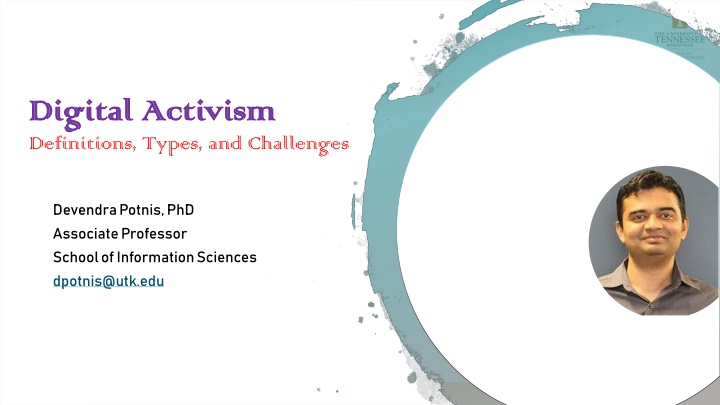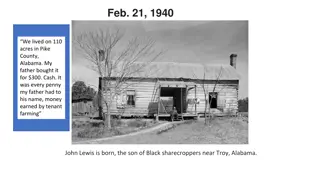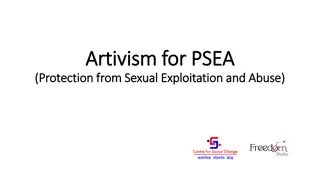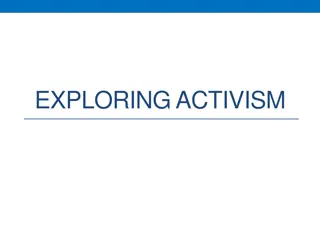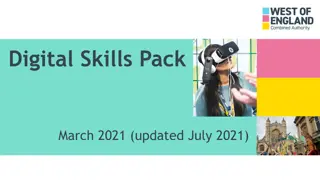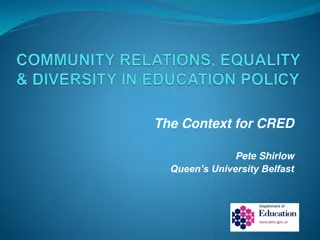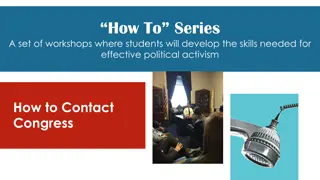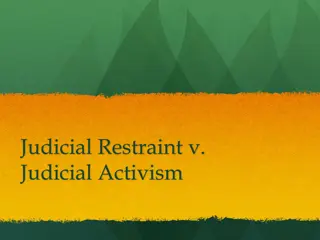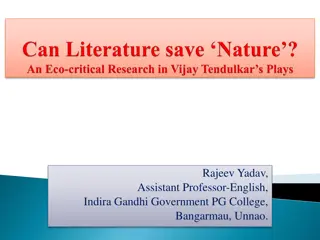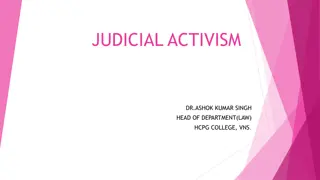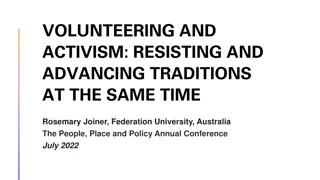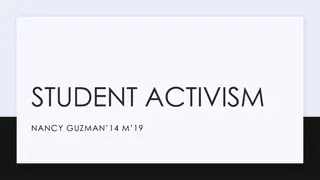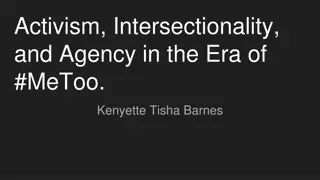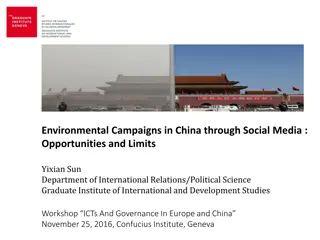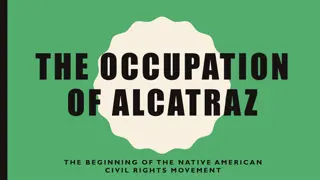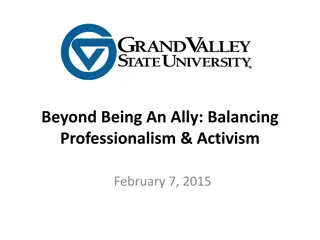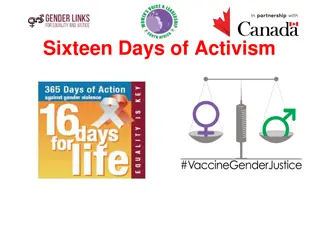Digital Activism: Definitions, Types, Challenges
This content discusses the definition of digital activism as social activism facilitated by information and communication technologies, various types such as clicking, metavoicing, asserting, online petitions, bots, e-funding, data activism, data leak, and hacking, as well as the challenges faced, including digital and media illiteracy, information literacy, and cause illiteracy.
Download Presentation

Please find below an Image/Link to download the presentation.
The content on the website is provided AS IS for your information and personal use only. It may not be sold, licensed, or shared on other websites without obtaining consent from the author.If you encounter any issues during the download, it is possible that the publisher has removed the file from their server.
You are allowed to download the files provided on this website for personal or commercial use, subject to the condition that they are used lawfully. All files are the property of their respective owners.
The content on the website is provided AS IS for your information and personal use only. It may not be sold, licensed, or shared on other websites without obtaining consent from the author.
E N D
Presentation Transcript
Digital Activism Digital Activism Definitions, Types, and Challenges Devendra Potnis, PhD Associate Professor School of Information Sciences dpotnis@utk.edu
1. Defining Digital Activism Social activism mediated through information and communication technologies to promote social movements (Selander & Jarvenpaa, 2016) Collective action for a cause Organized or individual-level efforts by citizens to influence social, political, cultural, and policy issues, using digital technologies (George & Leidner, 2019; Joyce, 2010) 2
2. Types of Digital Activism (1/3) 1. Clicking (Kavada, 2015; Majchrzak et al., 2013) Liking, upvoting, or following Large volumes of clicks Legitimacy, validation, and authority 2. Metavoicing (Kane et al., 2014) Sharing, retweeting, reposting, & commenting Reinforcing ideas, values, information Echo chamber Size of one s social networks 3. Asserting (Selander & Jarvenpaa, 2016) Content creation on social media Framing messages and opinion (George & Leidner, 2019) 3
Types of Digital Activism (2/3) 4. Online petitions (Whitehouse, 2020) e-Government petitions for citizens to request review of an issue A minimum number of signatures A guaranteed response 5. Bots (Salge & Karahanna, 2018) Robots (coding) operating on social media Challenging to distinguish bots from real people 6. E-Funding (Young, 2018) Use of technology to generate revenue for a cause Donations of cryptocurrencies, website retail click-throughs, and online auctions 4
Types of Digital Activism (3/3) 7. Data activism (Baack, 2015; Schrock, 2016) Promotes greater individual power over data held by others Open government data, Volunteers rescue, preserve, and promote open data 8. Data leak (Tufekci, 2014) Unauthorized dissemination of confidential information WikiLeaks 9. Hacking (Coleman, 2011; Jordan, 2002) To achieve social action or political objectives Cyberterrorism (Spreading virus, vandalizing websites, DoS attacks, etc.) 5
3. Challenges to Digital Activism (1/2) 1. Digital illiteracy (Kavada, 2015) How to use and troubleshoot routers, mobile devices, & social media? Coding for bots, hacking, etc. 2. Media illiteracy (Potnis, 2016) How to use SnapChat? WhatsApp? etc. 3. Information illiteracy (Potnis, 2015; Somin, 2016) How to evaluate information? Misinformation vs. Facts? Validating information 4. Cause illiteracy (World Bank, 2018) Lack of in-depth knowledge about issues, priority areas, multiple positions, etc. 6
Challenges to Digital Activism (2/2) 5. Lack of security (Tufekci, 2014) Threat to life, family members, infrastructure, devices, data, etc. 6. Lack of trust (Dias, 2017; Dredge, 2017; Funke, 2018) Institutions (e.g., governments), organizations, citizen journalism 7. Faulty and missing open data (Open Data Chapter, 2020) Lack of timely access to usable, current, relevant, trustworthy data 8. Lack of supporting infrastructure (ACWICT, 2017; Potnis & Gala, 2017; Sevenzo, 2018) Lack of timely access to tools (tech platforms) and services (data plans) 7
References (1/2) ACWICT (2017). State set to train 1m youth in digital literacy project. http://acwict.org/index.php/2017/04/25/state-set-train-1m-youth-digital-literacy-project/ last accessed 2018/12/04. Baack, S. (2015). Datafication and empowerment: How the open data movement re-articulates notions of democracy, participation, and journalism. Big Data & Society, 2(2), 2053951715594634. https://doi.org/10.1177/2053951715594634. Coleman, G. (2011). Hacker politics and publics. Public Culture, 23(3), 511 516. https://doi.org/10.1215/08992363-1336390. Dias, N.: The era of WhatsApp propaganda is upon us, http://foreignpolicy.com/2017/08/17/the-era-of-whatsapp-propaganda-is-upon-us/ last accessed 2018/12/04. Dredge, S.: Why political rebels love WhatsApp, https://www.theguardian.com/technology/2017/mar/05/political-rebels-whatsapp-encryption-technology-mps- security last accessed 2018/12/4. Funke, D.: Here s why fighting fake news is harder on WhatsApp than on Facebook, https://www.poynter.org/news/heres-why-fighting-fake-news-harder-whatsapp- facebook last accessed 2018/12/04. George,J., & Leidner, D. (2019). From clicktivism to hacktivism: Understanding digital activism, Information & Organization, 29(3). https://doi.org/10.1016/j.infoandorg.2019.04.001 Jordan, T. (2002). Activism!: Direct action, hacktivism and the future of society. Reaktion Books. Joyce, M. (2010). Digital activism decoded: The new mechanics of change. International Debate Education Association: New York. Kane, G., Johnson, J., & Majchrzak, A. (2014). Emergent life cycle: The tension between knowledge change and knowledge retention in open online coproduction communities. Management Science, 60(12), 3026 3048. https://doi.org/10.1287/mnsc.2013.1855. Kavada, A. (2015). Creating the collective: Social media, the Occupy Movement and its constitution as a collective actor. Information, Communication & Society, 18(8), 872 886. https://doi.org/10.1080/1369118X.2015.1043318. Majchrzak, A., Faraj, S., Kane, G. C., & Azad, B. (2013). The contradictory influence of social media affordances on online communal knowledge sharing. Journal of Computer-Mediated Communication, 19(1), 38 55. https://doi.org/10.1111/jcc4.12030. Open Data Charter (2020). Principles, https://opendatacharter.net/principles/. Potnis, D. (2011). Cell-phone-enabled empowerment of women earning less than $1 per day. IEEE Technology & Society, 30(2), 39-45 (2011). Potnis, D. (2015). Beyond access to information: Understanding the use of information by poor female mobile users in rural India. The Information Society, 31(1), 83-93. Potnis, D. (2016). Culture s consequences: Economic barriers to owning mobile phones experienced by women in India. Telematics and Informatics, 33(2), 356- 369. 8
References (2/2) Potnis, D. & Gala, B. (2017). Factors influencing electronic word-of-mouth among Indian youth: Implications for mobile governance, In: the Special Collection on eGovernment Innovations in India, 10th International Conference on Theory and Practice of Electronic Governance Proceedings, New Delhi, India, 107-114 Schrock, A. R. (2016). Civic hacking as data activism and advocacy: A history from publicity to open government data. New Media & Society, 18(4), 581 599. https://doi.org/10.1177/1461444816629469. Selander, L., & Jarvenpaa, S. L. (2016). Digital action repertoires and transforming a social movement organization. MIS Quarterly, 40(2), 331 352. Sevenzo, F.: Kenya election, BBC reports target voters, http://www.cnn.com/2017/07/31/africa/kenya-election-fake- news/index.html. Somin, I.: Why real-world governments don t have the consent of the governed--and why it matters. Washington Post. http://www.washingtonpost.com/news/volokh-conspiracy/wp/2016/01/27/why-real-world-governments-dont-have-the- consent-of-the-governed-and-why-it-matters/?utm_term-.b97acc2482ce last accessed 2018/12/04. Tufekci, Z. (2014). The medium and the movement: Digital tools, social movement politics, and the end of the free rider problem. Policy & Internet, 6(2), 202 208. https://doi.org/10.1002/1944-2866.POI362. Whitehouse (2020). https://petitions.whitehouse.gov/ World Bank (2018). Here are 10 ways to fight corruption, http://blogs.worldbank.org/governance/here-are-10-ways-fight- corruption 9
